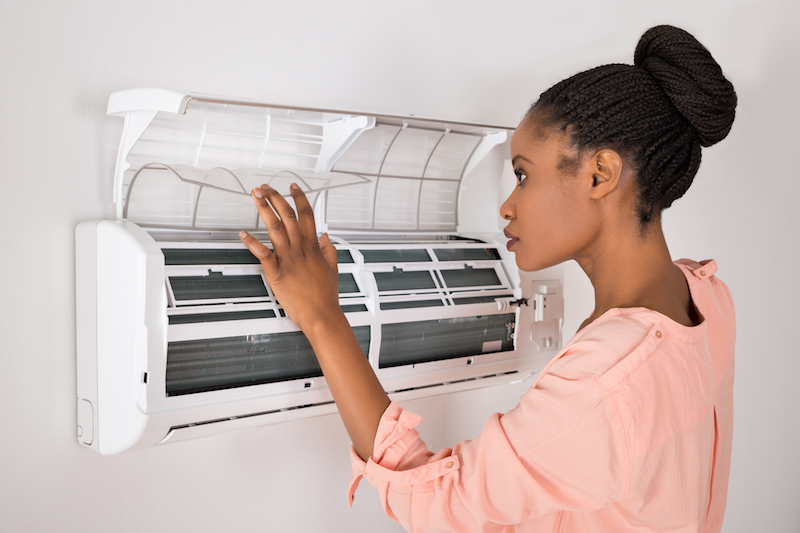
You shouldn’t need to compromise on comfort or empty your wallet to keep your house at the right temperature during hot days.
But what is the right temp, exactly? We discuss advice from energy pros so you can choose the best setting for your family.
Here’s what we advise for the most energy-efficient setting for air conditioning in The Bay Area.
Recommended Thermostat Settings for Summer
Most households find setting the thermostat at 72-73 degrees is ideal. However, if there’s a big difference between your inside and exterior temperatures, your electricity costs will be bigger.
These are our suggestions based on the U.S. Department of Energy (DOE) and ENERGY STAR®.
While at home: 78 degrees. While that appears too high, there are methods you can keep your residence cool without having the AC on constantly.
Keeping windows and curtains down during the day keeps cold air where it belongs—within your home. Some window coverings, including honeycomb shades or plantation shutters, are made to offer extra insulation and better energy conservation.
If you have ceiling fans in your house, the DOE says you can raise thermostat temperatures about 4 degrees higher without compromising comfort. That’s due to the fact they cool by a windchill effect. Because they cool people, not spaces, switch them off when you move from a room.
If 78 degrees still seems too uncomfortable at first glance, try conducting a test for about a week. Begin by increasing your thermostat to 78 degrees while you’re at your residence. Then, progressively lower it while adhering to the ideas above. You may be shocked at how refreshed you feel at a warmer temperature setting.
While away: 88 degrees. There’s no need to keep the AC going all day while your home is vacant. Turning the temperature 7–10 degrees warmer can save you as much as 5–15% on your cooling bills, according to the DOE.
When you arrive home, don’t be tempted to set your thermostat below 78 to cool your residence more quickly. This isn’t effective and typically produces a higher electricity bill.
A programmable thermostat is a helpful approach to keep your settings controlled, but you need to set programs. If you don’t set programs, you run the risk of forgetting to move the set temperature when you leave.
If you’re looking for a hassle-free solution, consider buying a smart thermostat. This thermostat connects with your phone, so it knows when you’re at home and when you’re out. Then it instinctively adjusts temperature settings for the biggest savings. How much exactly? An estimated $180 each year on heating and cooling, according to ENERGY STAR.
Another perk of getting a smart thermostat? You can use your phone to monitor and adjust temperature settings from almost anywhere.
While sleeping: Around 70 degrees. While ENERGY STAR recommends 82 degrees, that may be too uncomfortable for many families. The majority of people sleep better when their sleeping area is chilly, so that’s why the National Sleep Foundation advises 60–67 degrees. But that might be too cold, based on your clothing and blanket preference.
We advise trying a comparable test over a week, putting your temp higher and steadily lowering it to pick the best temp for your residence. On cool nights, you might discover keeping windows open at night and using a ceiling fan is a superior solution than using the air conditioner.
More Approaches to Save Energy This Summer
There are extra approaches you can spend less money on utility bills throughout the summer.
- Get an energy-efficient AC system. Central air conditioners only are effective for about 12–15 years and lose efficiency as they age. An upgraded air conditioner can keep your house comfier while keeping electricity bills down.
- Set annual air conditioner maintenance. Routine air conditioner maintenance keeps your equipment working properly and may help it run more efficiently. It could also help prolong its life span, since it allows pros to discover small issues before they lead to a major meltdown.
- Change air filters often. Read manufacturer instructions for changing your air filter. A clogged filter can lead to your system short cycling, or turn on and off too often, and drive up your electricity.
- Measure attic insulation levels. Almost 90% of residences in the United States don’t have adequate insulation, according to the Insulation Institute. Many southern climates should have 13–14” of attic insulation, while northern climates should have 16–18”.
- Have your ductwork inspected. Ductwork that has separated over time can leak cold air into your attic, walls or crawl space. This can lead to major comfort problems in your house, like hot and cold spots.
- Seal holes, doors and windows. Keep humid air where it belongs by sealing holes. You can also caulk or weather strip doors to keep more cold air within your home.
Use Less Energy This Summer with Contra Costa Heating & AC
If you want to use less energy during warm weather, our Contra Costa Heating & AC experts can provide assistance. Reach us at 510-343-9841 or contact us online for additional information about our energy-saving cooling options.

